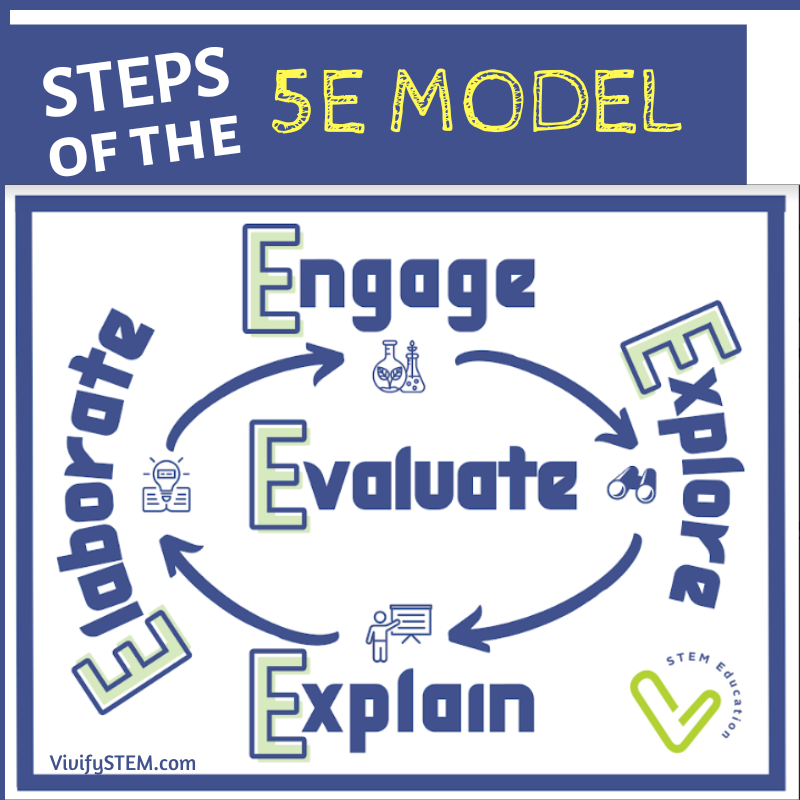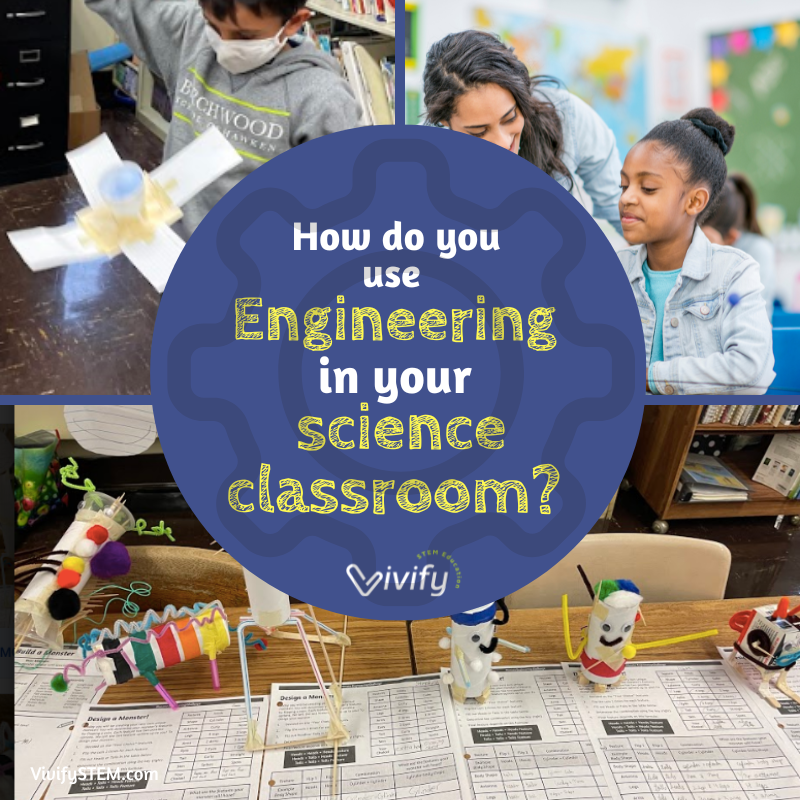Engineering and the 5E Science Model
Engineering and the 5E Science Model
Post by Michelle Bogden & Natasha Wilkerson
February 22, 2023
Are you looking to add engineering to your science classroom? Most educators use the 5E learning model to teach science concepts. Can engineering design fit into 5E science units? Yes! Read below as we break down:
Steps of 5E Science Learning Model
Adding Engineering in 5E Science Model
Example of an Engineering 5E Unit
What is the Science 5E Model?
The 5E science learning model is an instructional approach to teaching science through inquiry. Based on constructivist learning theory, the 5E model builds conceptual understanding from students’ experiences with phenomena (Bybee and Landes, 1990). 5E is especially useful when students have deeply held misconceptions. Instead of just telling students the information, this approach has students engage with the phenomena, question their ideas, build understanding, and apply knowledge. Here are some more details:
Knowledge Quest: The 5 E’s of Inquiry-Based Learning
San Diego County Office of Education: 5E Model of Instruction
The Steps of the 5E Learning Model:
Engage: Promote student curiosity through an interesting question, activity, or demonstration. Activities are ideally decontextualized and relevant to students. This hooks the students and a chance to collect prior knowledge.
Explore: Once students are hooked, it is time to explore ideas further. Ideally, this phase involves a concrete experience with the phenomena. Perhaps students conduct a lab or go outside and observe. Do not introduce vocabulary yet. All discussions should be in the language used by students.
Explain: Connect the experience to science concepts through a class discussion, think-pair-share, and direct instruction building from their experiences. Allow students to discuss and reflect as they work through conceptual understanding.
Elaborate: Provide students with an opportunity to apply knowledge to a new context. This can be an additional lab, homework assignment, presentation, or group discussion.
Evaluate: Continually assess students' understanding and ability to reach learning goals and key concepts. The evaluation step can range from informal formative assessment to an end-of-unit summative assessment.
Adding Engineering in 5E Science Model
We believe that engineering is a key component of STEM education. The Next Generation Science Standards have engineering practices as an important part of K-12 science standards. For example, in grades 3 - 5, students are expected to:
3-5-ETS1-1: Define a simple design problem reflecting a need or a want that includes specified criteria for success and constraints on materials, time, or cost.
3-5-ETS1-2: Generate and compare multiple possible solutions to a problem based on how well each is likely to meet the criteria and constraints of the problem.
3-5-ETS1-3: Plan and carry out fair tests in which variables are controlled and failure points are considered to identify aspects of a model or prototype that can be improved.
Engineering design can follow the process below. More details on engineering design can be found here: Engineering in the Science Classroom
You might be wondering - well, can't these steps fit into the 5E model where Engage is Identify the Problem? One problem is that engineering design is a skill, but the 5E model is meant to build conceptual understanding. Building skills requires modeling, practice, and feedback. However, we love adding an engineering design challenge as one of the steps of the 5E model! Here are some ideas to integrate engineering to support science learning:
Engage: Start a science unit with a fun engineering design challenge that builds interest or establishes a driving problem.
Explore: An engineering design lab can provide an experience with phenomena. For example, when designing a drag device, students may collect data that shows how a larger surface area slows down the device. This experience can be used to build a conceptual understanding of science topics.
Elaborate: After the explain phase, students apply science concepts to a design.
Evaluate: Students justify design decisions based on science concepts.
Note: completing an engineering design challenge will not generally lead to a conceptual understanding of science concepts. Explicit instruction is needed to support learning.
Example of an Engineering 5E Unit
Let’s take a look at an example of engineering in a scient unit! In our Intro to Genetics unit, the engineering design process is incorporated during the Explore phase. Students design and build a monster for an experience before introducing science concepts. Below we describe the steps.
Engage: Monsters Inc. Video Clip
Introduce the unit with a video clip from Monsters Inc. Discuss the following as a class:
What makes the monsters unique?
What features do the monsters have that make them unique from one another?
What features do you have that make you unique from other humans?
Explore: Monster Engineering Challenge
In this activity, students design their own genetically unique monster based on 2 variations of 8 different features (traits). Students will flip a coin to see how the features (traits) are expressed in their monster. These features are the constraints of the design challenge, along with available materials. Students will build a 3D version of their monster. While students are not using the full design process, they practice building and material processing skills important to engineering. When students finish their monsters, encourage them to compare them to their classmates.
Explain: Connect Monster to Science Concepts
After students build a monster using coin flips that select the traits, we connect this experience to:
Inheriting Traits
Dominant vs. Recessive
Genotype and Phenotype
The unit provides a mix of content reading, videos, class discussion questions, Think- Pair- Share, and check your understanding exercises. Some sample discussion questions:
How was flipping a coin for your monster related to inheriting traits?
Where do people get their traits from?
Describe a dominant and recessive trait of your monster.
Are dominant traits always more common than recessive traits?
Write the phenotype and genotype for different genetic combinations.
Elaborate: Inventory of Traits + Career Connections
Students then apply their learned knowledge of genetics by taking an inventory of 12 human genetic traits they possess. For example, they explore attached or detached earlobes, freckles or no freckles, and left-handed or right-handed. After gathering class data, students analyze through claim evidence and reasoning if dominant traits are more common than recessive traits. The elaborate phase is constructed to intentionally connect student understanding to science content with a real-life example, traits of themselves! This leads to a STEM Career Connection of a geneticist and how human traits are analyzed.
Evaluate
We continually assess students' understanding and their ability to reach learning goals and key concepts at several points throughout the unit. The evaluation step can range from formal to informal formative assessment to the end of the unit summative assessment. Both are provided throughout the unit.
8 Engineering Challenges that Apply Science
Engineering can be connected in a science inquiry unit through application in design decision. Students deepen content knowledge while also engaging in meaningful engineering practices. Below are some examples.
Hybrid Genetics Unit: The engineering design process is incorporated in the Elaborate phase of the 5E model. Students apply science concepts to design their own hybrid produce (see picture above).
Space Lander: Students learn about drag and then apply the concept that a larger surface area increases drag to a design challenge for a space lander.
Biomimicry STEM Unit: Engage students with real examples of biomimicry (engineering inspired by nature) and deepened their understanding with a 5E science unit + design lab!
Heat Shield STEM Challenge: Students learn about heat transfer and design a device that insulates from heat.
Musical Instrument STEM Challenge: Students learn about the properties of sound and then apply them to designing a musical instrument.
Simple Machines Toy Factory: Students learn about simple machines and apply concepts to design a toy factory.
Pinhole Camera STEM Challenge: Students will learn about light refraction and camera obscure and complete an engineering design challenge to build a pinhole camera to project an image on their pinhole image screen.
Moon Tower STEM Engineering Challenge: Students apply knowledge of circuits to design a welcome tower.
Cite: Bybee, R. W., and Landes, N. M. 1990. “Science for Life & Living: An Elementary School Science Program from Biological Sciences Curriculum Study.” The American Biology Teacher 52(2): 92-98.








